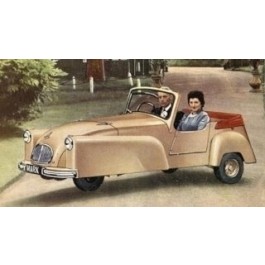In January 1949 the first 3-wheeled Bond appeared in Preston (UK) designed by Laurie Bond and made by Sharp’s Commercials Ltd. This first Bond was called the ’Mk A’ and was powered by a Villiers 125cc engine. The Bond "Mk A" initially was a very basic vehicle with a stressed skin aluminium body and no doors. Whilst the front of the vehicle had a girder type suspension the car had no rear suspension what so ever. The car also only had brakes on the back wheels and gear changing was by means of a lever on the dashboard. A deluxe model of the Bond “Mk A” was also made that was powered by a Villiers 197cc. Approximately 2000 “Mk A”’s were made until the were succeeded by the Bond “Mk B” in June 1951. Whilst this shared many characteristics with the “Mark A” the “Mk B” featured rear suspension which gave a much more comfortable ride. It also came in four versions (a 2 - 3 seater Tourer, a Minivan, a Minitruck and a Family "Safety Saloon") Although the "Mk B" had many improvements over the Mk A, only 1414 were made.
In January 1953 the Bond “Mark C” was introduced and was totally different to the earlier Bonds. The “Mark C” featured “dummy wings” at the front of the car that actually housed a new steering device that allowed the car to be steered at 180 degrees. At the time for a 3-wheeler to be driven on a motorcycle license it could not have a reverse gear, the 180 degree steering therefore meant that the Bond “Mark C” could turn around within its own length. In May 1956 the Bond "Mark D" was produced with the Bond "Mark E" in October 1957, the Bond "Mark F" in November 1958 and the Bond "Mark G" in August 1961.
Each variation of the Bond saw many improvements and enhancements to the range with the Bond “Mark F” being the most successful of all the Bonds. From the 125cc Villiers engine used in the Bond “Mark A” to the 250cc Villiers engine in the “Mark G” Bond’s had not been known for their speed despite the Mk G Twin being capable of reaching 60 mph. The idea of Bonds being slow in the past was shattered in August 1965 with the introduction of the ’875’ model. The 875 was fitted with a water-cooled low compression 875cc engine from the Commer Van which gave the vehicle a top speed of 80 - 90 mph. The body of the 875 was completely made from fibreglass and had aluminium doors. All the mechanical parts of the 875 along with the engine were parts directly from the Hillman Imp. The 875 was available in a saloon version as well as in a Ranger van form and sold very well. As a result the Bond was in direct competition with the 700cc Reliant Regal and even though Bond were only manufacturing 1,500 3-wheelers a year compared to Reliant’s 15,000 3-wheelers it was enough to make Reliant take over and buy Bond in February 1969.
In August 1970 Reliant stopped all Bond models but prior to this, they had commissioned Ogle (their design consultants) to produce a sports 3-wheeler for the "young" generation. This was to be sold under the Bond name as the "Bond Bug". Introduced in June 1970, the early Bond Bugs were manufactured at the Bond factory in Preston but shortly afterwards when the factory closed, Bug production was moved over to Reliant at Tamworth. (UK). The Bond Bug used all the mechanics of a Reliant Regal including the 700cc water-cooled engine. The only non-Regal part was the coil spring suspension at the rear of the car (instead of the Regal’s telescopic damper.) The Bug featured a complete glass fibre body in a futuristic wedge shape that had a lift up front canopy that incorporated the side windows and allowed access to the vehicle. Every Bug that was made was painted bright orange with black seats and trim. The Bond Bug however was not as successful as Reliant had hoped and so after some 2,268 vehicles were built manufacture stopped in 1974, and the Bond name came to an end. Although Bond is mainly known for its range of 3-wheeler vehicles it had also over the years made a Bond “Sea Ranger” speedboat in 1960, a 4-wheeler Sports car in 1963 (the Bond Equipe), and Bond P1 - P4 scooters from 1957. Interestingly many parts from the Bond 3-wheelers were used to make the scooters.





